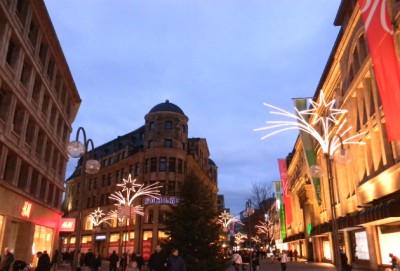COLOGNE, GERMANY. Assuming I’m like most people, when I think of Germany as a whole I picture beautiful churches, several castles, and lively bars with a huge beer selection. Stereotypes exist for a reason, right? This is what I was expecting when I scheduled three nights in Cologne, Germany at the start of 2014. What I experienced, though, could not have been more different. These are a few points to be aware of when you plan a visit to Cologne.
1. Cologne is home to the largest church in Germany, and not much else
The Dom Cathedral is visible at almost any place in the city. If you arrive by train at Köln Hauptbahnhof, the Dom is a stunning visual as soon as you exit the station. The inside sanctuary is just as impressive as is its hundreds of years of history. However, there are not many more tourist sites within the city. Despite there being a university in Cologne, it seemed that young people were hard to find out and about. I visited at the very beginning of January, and was disappointed to find that the famous Christmas markets were already closed. They close by December 23rd. Therefore, the city seemed to lack the attractions I was anticipating.
2. Cologne is defined by their locally produced, specialty beer, Kölsh
Another part of Germany I could not wait to experience is the variety of different regional beers available. If this is also one of your reasons for coming to Germany, avoid Cologne. Cologne is prideful of their local specialty beer, Kölsh. I should have done my research! It’s a light, yellow lager. The culture behind the beer is interesting. In Cologne there are several traditional breweries such as Peters Brauhaus, Fruh am Dom, and Gaffel-Haus. These are massive restaurants with over 1500 places to sit. Along with great, traditional German dishes, the Kölsh is brought around in a metal wreath, and your glass is immediately refilled if the waiter sees you are running low. A charming trick is to place your coaster on top of your glass if you’ve had enough. Although I’m glad I was able to experience this German tradition, I wish I had known this was what we were in store for. Every bar in the city usually had only the house Kölsh on tap, otherwise the other beers you may have wanted would be by the bottle.

Cologne’s specialty beer, locally brewed and served in traditional brewery houses throughout the city
3. Cologne is a retail paradise
The majority of the city center is dedicated to shopping. This is great, if you’re looking for an overwhelming amount of fashion and household items with money to blow. I would not recommend this city for young people traveling on a budget. I found that most of the city is inhabited by older, well-established Germans who have money to spend at ritzy cafes. I am not exaggerating when I say we spend over thirty minutes our first night there leaving our hostel and trying to find a decent bar filled with people under the age of forty. We ended up at an Irish bar near the cathedral, Irish Pub Flanagans. We were finally able to enjoy a hefeweizen and found a younger crowd, just not in the way we were looking forward to.
The moral to the story is not to assume that all of a country is the same. I think Cologne is an exception to most cities in Germany, and if you are looking for an insight to Kölsh culture or want to experience the cathedral, those are the only aspects I could recommend it for.
USEFUL INFORMATION:
Köln Hauptbahnhof is located about one hour from Aachen, Germany, at the border of Germany and Belgium. DB Bahn, the German train system, is timely, and the Köln station stop is announced in English.
Locations:
Irish Pub Flanagans, Alter Markt 36
Fruh am Dom, Am Hof 12-14, Altstadt-Nord
Gaffel-Haus, Alter Markt 20-22, Altstadt-Nord
Prices:
0.2L glass of Kölsh €1,80
0.5L bottled beer €3,50 – 4,50


